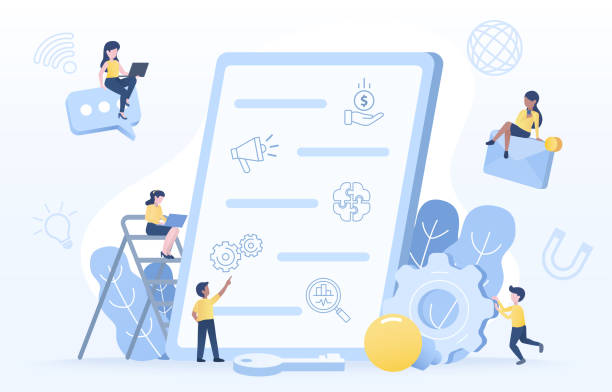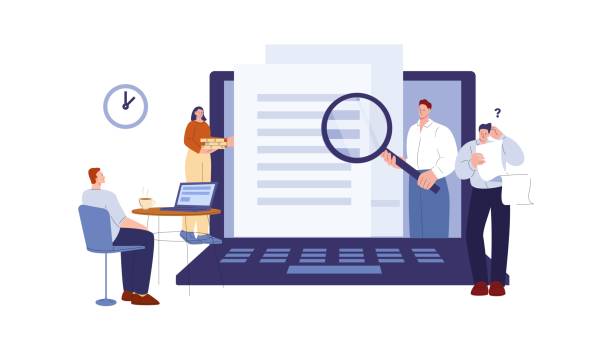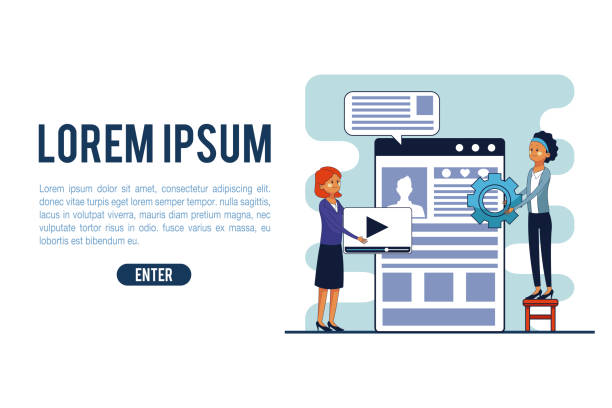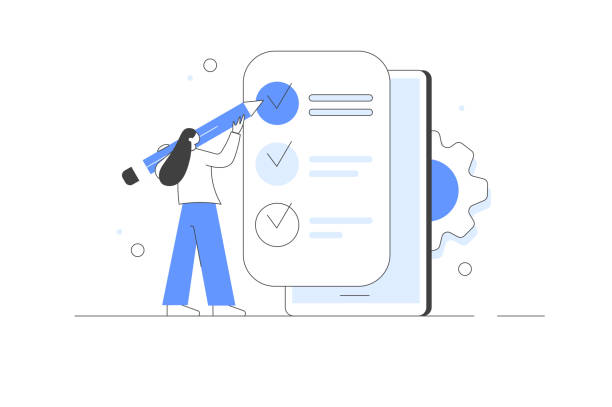Introduction and the Necessity of Multilingual Website Design in Today’s World

In the era of globalization, businesses must operate beyond their geographical borders to survive and grow.
This is where the importance of #multilingual_website_design and #international_market becomes evident.
Your website is the digital storefront of your business, and its ability to be displayed in different languages paves the way for greater_reach to a global audience.
A single-language website, whether in Persian or English, covers only a small fraction of the global market’s potential.
It is an undeniable fact that internet users prefer to receive information in their native language.
Therefore, to expand influence and increase market share, there is an urgent need for the ability to communicate with users from different cultures and languages.
Multilingual website design is not just a luxury option; it is a strategic necessity for any business dreaming of global expansion.
This approach allows you to deliver your message to millions more, gain their trust, and ultimately increase sales and customer loyalty.
This process is not just a technical measure, but a cultural and marketing investment that will yield significant returns.
Are you bothered by losing customers due to your online store’s outdated appearance or slow speed? RasaWeb’s expert team solves these problems with professional online store design!
✅ Increase customer trust and brand credibility
✅ Blazing speed and excellent user experience
Get a free consultation with RasaWeb now ⚡
Exploring Challenges and Opportunities in Implementing Multilingual Websites

Multilingual website design, while offering countless opportunities, also comes with its own challenges.
One of the most important challenges is content and translation management.
Simply translating content word-for-word is not enough; special attention must be paid to localizing and culturally adapting the content for each language.
Does the translated text convey the same feeling and original meaning? Are the idioms and jokes understandable in the target culture? These questions create challenging content that requires deep analysis.
Another challenge relates to URL structure and SEO (Search Engine Optimization).
Whether to use subdomains (e.g., `fr.yourdomain.com`), subdirectories (e.g., `yourdomain.com/fr`), or country-specific domains (e.g., `yourdomain.fr`) can significantly impact site rankings in search engines.
Managing different versions of a page for various languages and ensuring that search engines display the correct version for users in each region are among the technical complexities of this process.
However, the opportunities arising from these efforts are immense.
Increasing organic traffic from different parts of the world, creating a competitive advantage in new markets, and improving brand reputation internationally are among the most important opportunities.
A correct implementation not only minimizes challenges but can also bring significant growth to your business.
Common Technical Approaches for Multilingual Website Design and Choosing the Best Option

When designing a multilingual website, choosing the right technical approach for URL structuring is a key and specialized decision that directly impacts SEO and user experience.
There are three main approaches: using country-specific top-level domains (ccTLDs), using subdirectories, and using subdomains.
Each of these methods has its own advantages and disadvantages.
ccTLDs like `.fr` for France or `.de` for Germany provide the highest level of trust and localization to search engines and appear to perform very strongly for ranking in a specific country, but their maintenance and management costs are high.
Subdirectories like `yourdomain.com/fr` perform well in terms of SEO, are easier to manage, and all the authority of the main domain is passed to them.
This method is often recommended because it is both SEO-efficient and easier to manage than ccTLDs.
Subdomains like `fr.yourdomain.com` are also an option, which, although treated as independent websites by Google, can still be used for multilingual SEO, although they may require more effort to build authority.
Choosing the best option depends on your business goals, budget, and technical resources.
Consulting with SEO specialists and web developers is crucial to make the right decision to ensure that the chosen structure provides the best support for your website’s future growth.
Table 1: Comparison of Technical Approaches for Multilingual Websites
| Approach | URL Example | Advantages | Disadvantages | SEO Recommendation |
|---|---|---|---|---|
| Country Code Top-Level Domain (ccTLD) | example.fr |
Strongest localization signal, high local credibility | High cost and management, requires separate domain authority | Excellent for targeted country-specific markets |
| Subdirectory | example.com/fr/ |
Easy management, main domain authority is shared | Appears slightly less localized than ccTLD | Highly recommended and balanced option |
| Subdomain | fr.example.com |
Content separation, hosting on different servers | May be considered independent sites, requires building separate authority | Acceptable option, but not as much as subdirectory |
The Importance of User Experience (UX) and User Interface (UI) in Multilingual Websites

Successful multilingual website design goes beyond mere translation of words and heavily relies on User Experience (UX) and User Interface (UI).
Users from every geographical region have their own expectations and habits when interacting with websites.
This is where cultural details, such as text direction (right-to-left or left-to-right), symbols, colors, and even font types, play a crucial role.
For example, the color red symbolizes love in some cultures and danger or anger in others.
Therefore, the UX/UI design team must be aware of these subtle differences.
Placing a language switcher in a clear and accessible location for users is essential, preferably in the site’s header or footer.
Also, ensuring that all UI elements, from buttons to forms, are correctly translated into the desired language and that there is sufficient space for longer texts in specific languages, is very important.
The educational nature of this approach means a deep understanding of user needs.
In other words, you must provide a website that aligns not only linguistically but also visually and culturally with the audience of each language to provide a seamless and comfortable experience for all visitors.
This attention to detail transforms a multilingual website from merely a translation tool into a powerful and effective communication platform.
Does your current corporate website turn visitors into customers or drive them away? Solve this problem forever with professional corporate website design by RasaWeb!
✅ Create strong credibility and branding
✅ Attract target customers and increase sales
⚡ Get a free consultation now!
Multilingual SEO: How to Increase International Traffic?

Multilingual website design without a strong SEO strategy is like building a bridge that leads nowhere.
Multilingual SEO means not only translating keywords but also conducting comprehensive research on user search behavior in each language and culture.
Each language has its own dialects and idioms that may produce different keywords for similar searches.
Correct use of the hreflang tag in HTML code or XML sitemap is vital for search engines to understand which version of the page is suitable for which language and geographical region.
These tags help Google and other search engines prevent duplicate content and display the correct language version to the appropriate users, which is very important for local ranking.
In addition, site loading speed, mobile compatibility, and overall user experience in each language are important SEO factors.
The most specialized part of this process is ensuring that URLs, titles, meta descriptions, and content of each page are carefully optimized for the target language.
Internal and external link-building strategies should also be implemented with different languages in mind.
By correctly implementing these tips, you can significantly increase your website’s organic traffic from international markets and achieve your global marketing goals.
Content Management in Multilingual Sites: Strategies and Tools

Content management in a multilingual website can become a complex and time-consuming task unless appropriate strategies and tools are considered.
One of the most important decisions in multilingual website design is choosing a Content Management System (CMS) that fully supports multilingual capabilities.
Many popular CMSs like WordPress (with plugins like WPML or Polylang), Drupal, or Joomla, offer internal features or plugins for multilingual content management.
It is important that your chosen system allows for parallel creation and updating of content in different languages, and also has an efficient workflow for content translation and review.
This includes assigning roles to translators, editors, and publishers to ensure that content is of high quality and error-free before publication.
Using a central database for content in the original language and then branching it for other languages can help maintain content consistency and integrity.
Furthermore, Translation Management Systems (TMS) can automate the translation process and help maintain Translation Memory and terminology, leading to reduced costs and increased translation speed over time.
Specialization in this section means choosing the best solution for every aspect of the content production and publication process on an international scale.
Localization Beyond Translation: Cultural and Marketing Importance in Multilingual Websites

Many assume multilingual website design merely means text translation, but the reality is that this process goes far beyond and encompasses the concept of Localization.
Localization means a complete adaptation of content, design, and website functionality to the culture, values, laws, and even shopping habits of audiences in a specific region.
This includes changes in currency, date and time formats, phone numbers, and even images that might be meaningful in one culture and meaningless or offensive in another.
For instance, a joke that is funny in English might not only be bland but even cause misunderstanding in Japanese.
This part of the job is fascinating, as you encounter deep cultural differences and learn how to leverage them to your advantage.
Additionally, marketing strategies and Calls to Action should also be localized to align with the expectations and communication styles of audiences in each language.
Did you know that in some cultures, direct communication is less accepted? These cultural analyses are analytical and essential for success.
Effective localization builds a deeper sense of trust and connection with customers and shows that you respect their needs and cultural differences, which ultimately leads to increased conversion rates and customer loyalty.
Table 2: Key Aspects of Localization (Beyond Translation)
| Localization Aspect | Description | Example |
|---|---|---|
| Currency and Number Format | Displaying prices and numbers with local currency and format | US Dollar, Euro, Rial; using comma or dot for decimal separator |
| Date and Time | Adapting to common date formats (day/month/year) and time zones | MM/DD/YYYY in USA, DD/MM/YYYY in Europe |
| Images and Graphics | Using images that are appropriate and meaningful for the target culture | Avoiding specific religious or cultural symbols in global design |
| Local Laws and Regulations | Complying with laws related to privacy, taxation, and e-commerce | GDPR laws in Europe, tax laws of each country |
| Payment and Shipping Methods | Offering popular payment and delivery options in the region | Payment with PayPal, local credit card, or bank transfer |
Choosing the Right Platform for Multilingual Website Design

Choosing the right platform is a vital step in the multilingual website design process.
The market is full of diverse options, from ready-made Content Management Systems (CMS) to programming frameworks that allow for custom development.
For many small and medium-sized businesses, CMSs like WordPress are very popular options due to their ease of use, large user community, and the availability of powerful multilingual plugins (such as WPML or Polylang).
These plugins enable content translation, multilingual URL management, and even coordination with professional translators.
For larger projects with more complex needs, Drupal or Joomla also offer powerful multilingual capabilities.
Drupal, due to its high flexibility and scalability, is an ideal option for enterprise websites and government projects that require complex data structures and precise control.
If you need extensive customization and have the necessary budget and development team, using web development frameworks like Laravel or Rails can also provide completely custom solutions.
These methods provide full control over every aspect of the website but require higher technical expertise.
The most specialized platform choice should be made based on your business’s current and future needs, the technical team’s capabilities, and the available budget to achieve the optimal long-term result.
Does your current online store design cause you to lose customers and sales?
RasaWeb is your solution with modern and user-friendly online store designs!
✅ Significantly increase conversion rates and sales
✅ Create strong branding and build customer trust
⚡ Get a free online store design consultation from RasaWeb now!
Legal and Privacy Considerations in Multilingual Websites

When designing a multilingual website and entering global markets, adhering to the legal considerations and privacy laws of different countries is of particular importance.
This aspect is often overlooked but can lead to heavy fines and damage to brand reputation.
For example, GDPR regulations in the European Union are mandatory for any business that collects or processes European user data, regardless of where that business’s servers are located.
This includes requirements for transparency in data collection, user consent, and the right to access and delete information.
In addition to GDPR, countries like California (CCPA) and Brazil (LGPD) also have their own specific privacy laws that must be carefully observed.
The dynamic nature of these legal developments indicates that the digital environment is rapidly changing, and staying up-to-date with these regulations is essential to avoid legal problems.
All privacy policies, terms and conditions, and cookie declarations must be carefully translated into all languages your website supports and localized for each geographical region.
Also, appropriate mechanisms for obtaining user consent (e.g., multilingual cookie banners) must be ensured.
It is recommended to consult with an international legal expert to ensure full compliance of your multilingual website with all relevant laws in your target markets.
Continuous Maintenance and Updates for Sustainable Multilingual Website Success

Multilingual website design is the starting point of your journey towards global success, but its continuous maintenance and updates are the key to sustainable success.
A static website that is rarely updated quickly loses its appeal and drops in search engine rankings.
This is especially important for multilingual websites that need to manage content in multiple languages.
Regular content updates, such as new blog articles, product news, or service updates, not only keep users engaged but also signal to search engines that your website is active and relevant.
In addition to content, it is necessary to periodically review the website’s technical performance.
This includes checking for broken links, page loading speed in different parts of the world, and compatibility with various browsers.
Updating the CMS platform and its plugins is also essential for optimal security and performance.
Furthermore, continuous monitoring of user feedback and analysis of website traffic data in each language helps you identify strengths and weaknesses and adjust your strategies for improving user experience and SEO in the future.
Continuous guidance and meticulous planning for maintenance ensure that your investment in multilingual website design yields the best possible returns and maintains a strong and effective presence in international markets.
Frequently Asked Questions
| Question | Answer |
|---|---|
| What is a multilingual site? | A site whose content is available to users in more than one language. |
| Why should I make my site multilingual? | To reach more audiences in global markets, improve user experience, and boost international SEO. |
| What are the technical approaches for building a multilingual site? | Using subdirectories, subdomains, or URL parameters to differentiate languages. |
| What effect does multilingual design have on SEO? | By targeting local keywords and providing content in users’ native languages, the site’s ranking in search engines for those regions improves. |
| What are the challenges of multilingual website design? | Content translation management, right-to-left (RTL) direction support, technical issues related to language addressing, and maintaining design consistency. |
| How do we choose the languages for a multilingual site? | Based on target audience analysis, desired markets, and current site traffic data (if available). |
| What is RTL support and why is it important for some languages? | Right-to-Left is the direction of displaying text and page elements from right to left, which is essential for languages like Persian, Arabic, and Hebrew. |
| How do we manage multilingual site content? | Using Content Management Systems (CMS) with multilingual capabilities, translation plugins, or professional translation services. |
| What is the user experience (UX) like in a multilingual site? | The ability to easily change languages should be provided, and the translated content should be of high quality so that users feel comfortable. |
| Which are the common CMS platforms for multilingual sites? | WordPress (with plugins like WPML), Joomla, Drupal, and Shopify (with relevant settings or plugins). |
And other services of RasaWeb Advertising Agency in the field of advertising
Smart Digital Advertising: Designed for businesses looking to attract customers through Google Ads management.
Smart Website Development: A professional solution for improving SEO ranking with a focus on Google Ads management.
Smart Advertising Campaign: An innovative service for increasing digital branding through key page optimization.
Smart Conversion Rate Optimization: An effective tool to improve SEO ranking with the help of key page optimization.
Smart Social Media: A creative platform for improving customer behavior analysis with custom programming.
And more than hundreds of other services in the field of internet advertising, advertising consulting, and organizational solutions
Internet Advertising | Advertising Strategy | Advertorial
Resources
Multilingual Website Design Articles
International Website Design
Multilingual Website Design Tutorial
How to Build a Multilingual Website
? In today’s competitive world, a strong online presence is key to success. RasaWeb Afarin Digital Marketing Agency offers comprehensive services including fast website design, SEO, and social media management, to elevate your business. For a free consultation and to learn more about our services, contact us today. 021-91097325
📍 Tehran, Mirdamad Street, next to the Central Bank, South Kazeroon Alley, Ramin Alley, No. 6



